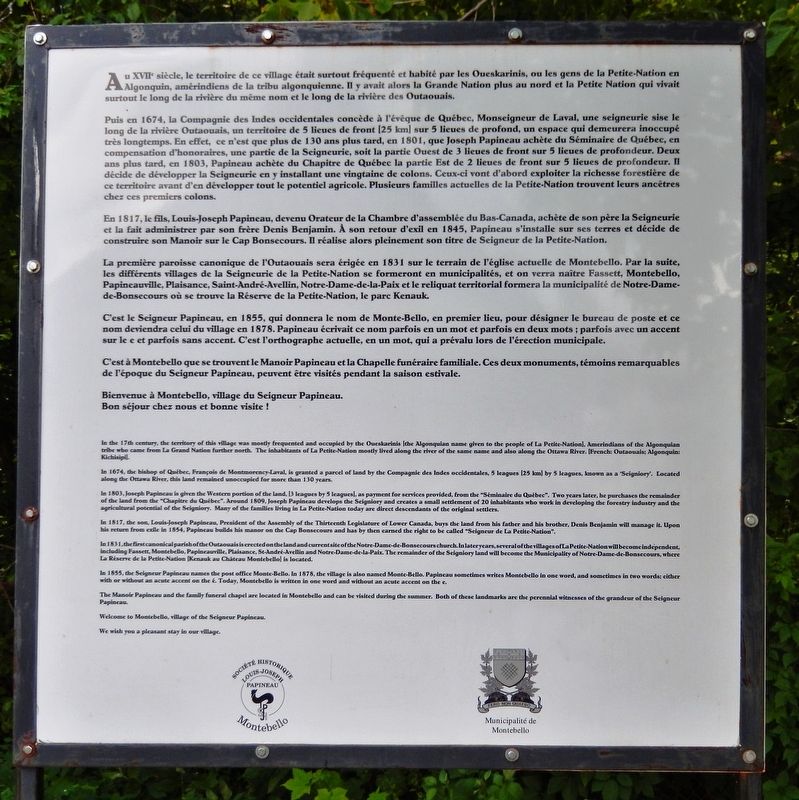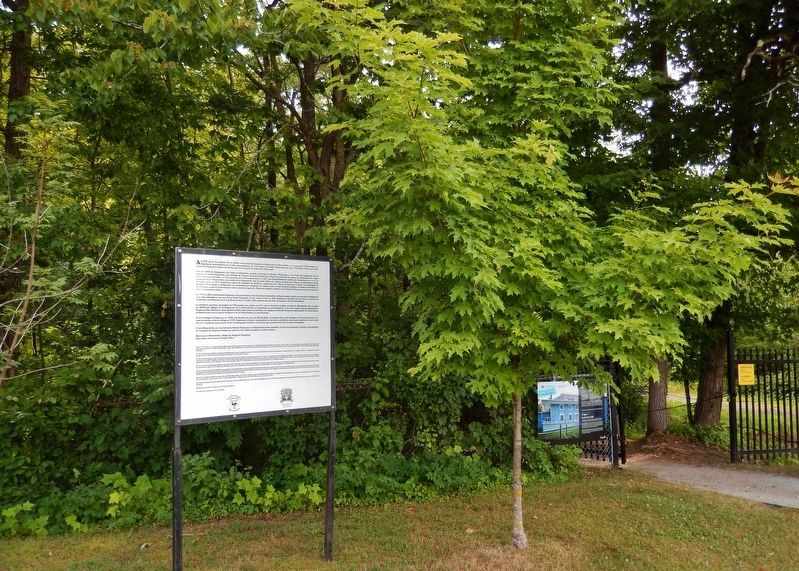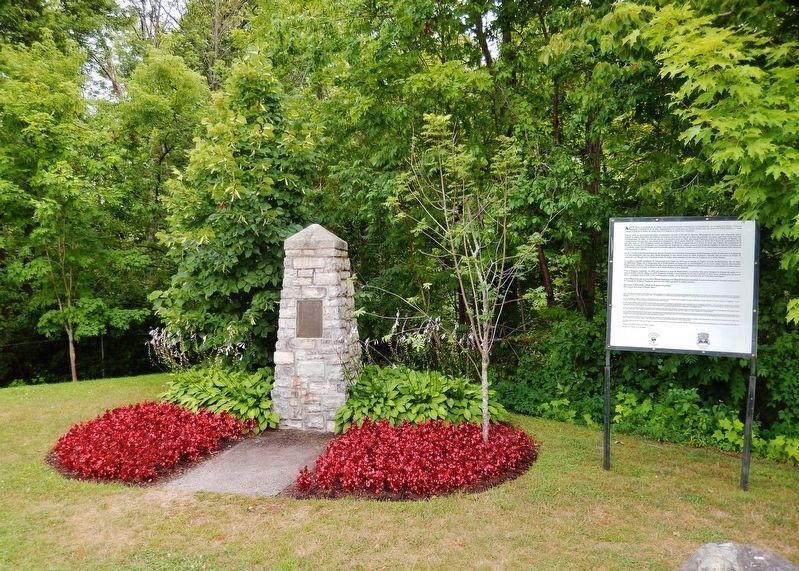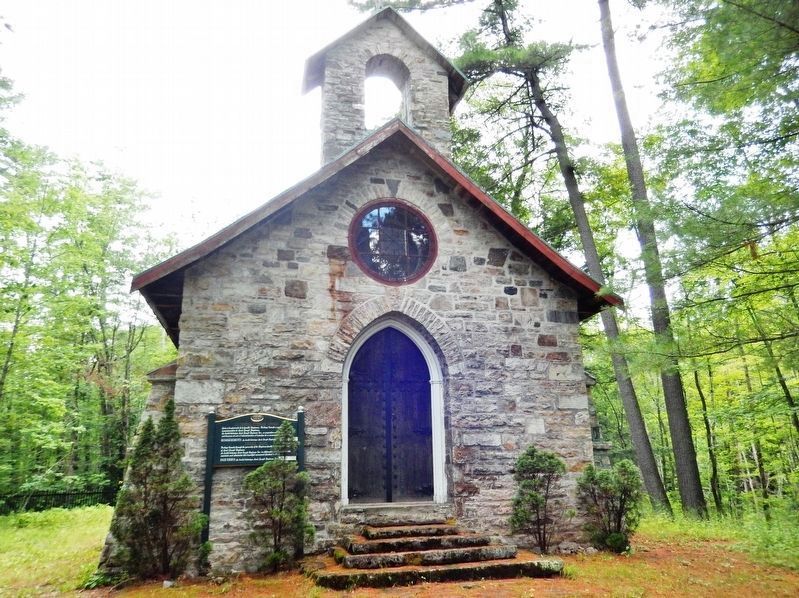Montebello in Papineau, Québec — Central Canada (French-Canadian)
Histoire de Montebello / History of Montebello
Inscription.
Au XVIIe siècle, le territoire de ce village était surtout fréquenté et habité par les Oueskarinis, ou les gens de la Petite-Nation en Algonquin, amérindiens de la tribu algonquienne. Il y avait alors la Grande Nation plus au nord et la Petite Nation qui vivait surtout le long de la rivière du même nom et le long de la rivière des Outaouais.
Puis en 1674, la Compagnie des Indes occidentales concède à l’évêque de Québec, Monseigneur de Laval, une seigneurie sise le long de la rivière Outaouais, un territoire de 5 lieues de front (25 km) sur 5 lieues de profond, un espace qui demeurera inoccupé très longtemps. En effet, ce n’est que plus de 130 ans plus tard, en 1801, que Joseph Papineau achète du Séminaire de Québec, en compensation d’honoraires, une partie de la Seigneurie, soit la partie Ouest de 3 lieues de front sur 5 lieues de profondeur. Deux ans plus tard, en 1803, Papineau achète du Chapitre de Québec la partie Est de 2 lieues de front sur 5 lieues de profondeur. Il décide de développer la Seigneurie en y installant une vingtaine de colons. Ceux-ci vont d’abord exploiter la richesse forestière de ce territoire avant d’en développer tout le potentiel agricole. Plusieurs familles actuelles de la Petite-Nation trouvent leurs ancêtres chez ces premiers colons.
En 1817, le fils, Louis-Joseph Papineau, devenu Orateur de la Chambre d’assemblée du Bas-Canada, achète de son père la Seigneurie et la fait administrer par son frère Denis Benjamin. À son retour d’exil en 1845, Papineau s’installe sur ses terres et décide de construire son Manoir sur le Cap Bonsecours. Il réalise alors pleinement son titre de Seigneur de la Petite-Nation.
La première paroisse canonique de l’Outaouais sera érigée en 1831 sur le terrain de l’église actuelle de Montebello. Par la suite, les différents villages de la Seigneurie de la Petite-Nation se formeront en municipalités, et on verra naître Fassett, Montebello, Papineauville, Plaisance, Saint-André-Avellin, NotreDame-de-la-Paix et le reliquat territorial formera la municipalité de Notre-Dame-de-Bonsecours où se trouve la Réserve de la Petite-Nation, le parc Kenauk.
C’est le Seigneur Papineau, en 1855, qui donnera le nom de Monte-Bello, en premier lieu, pour désigner le bureau de poste et ce nom deviendra celui du village en 1878. Papineau écrivait ce nom parfois en un mot et parfois en deux mots; parfois avec un accent sur le e et parfois sans accent. C’est l’orthographe actuelle, en un mot, qui a prévalu lors de l’érection municipale.
C’est
à Montebello que se trouvent le Manoir Papineau et la Chapelle Funéraire familiale. Ces deux monuments, témoins remarquables de l’époque du Seigneur Papineau, peuvent être visités pendant la saison estivale.
Bienvenue à Montebello, village du Seigneur Papineau.
Bon séjour chez nous et bonne visite !
In the 17th century, the territory of this village was mostly frequented and occupied by the Oueskarinis (the Algonquian name given to the people of La Petite-Nation), Amerindians of the Algonquian tribe who came from La Grand Nation further north. The inhabitants of La Petite-Nation mostly lived along the river of the same name and also along the Ottawa River, (French: Outaouais; Algonquin: Kichisipi).
In 1674, the bishop of Quebec, Francois de Montmorency-Laval, is granted a parcel of land by the French West India Company, 5 leagues [25 km] by 5 leagues, known as a “Seigniory.” Located along the Ottawa River, this land remained unoccupied for more than 130 years.
In 1803, Joseph Papineau is given the Western portion of the land, [3 leagues by 5 leagues], as payment for services provided, from the "Séminaire du Quebec". Two years later, he purchases the remainder of the land from the "Chapitre du Quebec". Around 1809, Joseph Papineau develops the Seigniory and creates a small settlement of 20 inhabitants who work in developing
the forestry industry and the agricultural potential of the Seigniory. Many of the families living in La Petite-Nation today are direct descendants of the original settlers.
In 1817, the son, Louis-Joseph Papineau, President of the Assembly of the Thirteenth Legislature of Lower Canada, buys the land from his father and his brother, Denis Benjamin will manage it. Upon his return from exile in 1854, Papineau builds his manor on the Cap Bonsecours and has by then earned the right to be called "Seigneur de La Petite-Nation".
In 1831, the first canonical parish of the Outaouais is erected on the land and current site of the Notre-Dame-de-Bonsecours church. In later years, several of the villages of La Petite-Nation will become independent, including Fassett, Montebello, Papineauville, Plaisance, St-André-Avellin and Notre-Dame-de-la-Paix. The remainder of the Seigniory land will become the Municipality of Notre-Dame-de-Bonsecours, where La Réserve de la Petite-Nation [Kenauk au Chateau Montebello] is located.
In 1855, the Seigneur Papineau names the post office Monte-Bello. In 1878, the village is also named Monte-Bello. Papineau sometimes writes Montebello in one word, and sometimes in two words; either with or without an acute accent on the e. Today, Montebello is written in one word and without an acute accent on the e.
The Manoir Papineau and the family
funeral chapel are located in Montebello and can be visited during the summer. Both of these landmarks are the perennial witnesses of the grandeur of the Seigneur Papineau.
Welcome to Montebello, village of the Seigneur Papineau.
We wish you a pleasant stay in our village.
Topics. This historical marker is listed in these topic lists: Colonial Era • Native Americans • Settlements & Settlers.
Location. 45° 38.984′ N, 74° 56.581′ W. Marker is in Montebello, Québec, in Papineau. Marker can be reached from Rue Notre Dame (Québec Route 148) west of Rue Saint Henri, on the left when traveling west. Marker is located at the Rue Notre Dame entrance to the Manoir Papineau National Historic Site. Touch for map. Marker is at or near this postal address: 500 Rue Notre Dame, Montebello QC J0V 1L0, Canada. Touch for directions.
Other nearby markers. At least 8 other markers are within walking distance of this marker. In Memoriam (here, next to this marker); La Gare / The Train Station (within shouting distance of this marker); La Maison J. N. Daoust / The J.N. Daoust House (within shouting distance of this marker); La Banque Nationale / National Bank (about 90 meters away, measured in a direct line); La Maison de Cyrille Lefebvre / Cyrille Lefebvre House (about 90 meters away); La Maison du Jardinier / Gardener's House
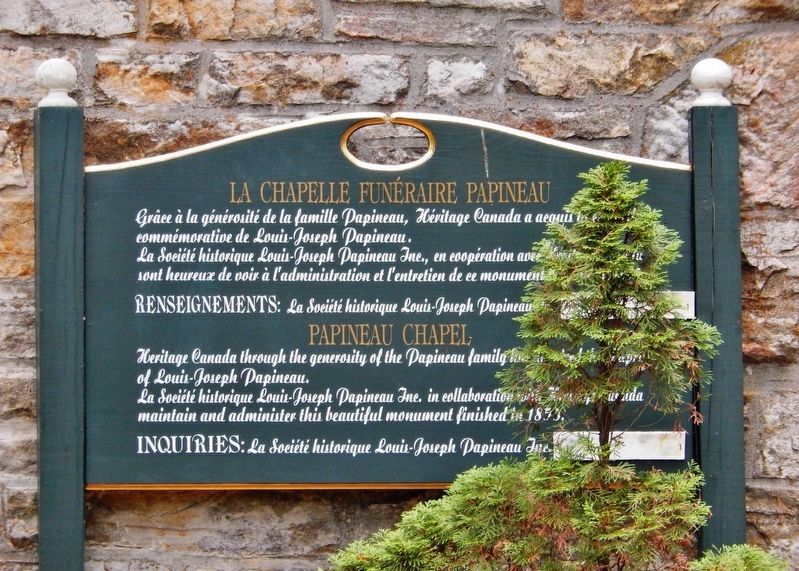
Photographed By Cosmos Mariner, August 9, 2019
5. La Chapelle Funéraire Papineau / Papineau Chapel
Grâce à la générosité de la famille Papineau a acquis la chapelle commémorative de Louis-Joseph Papineau. La Société historique Louis-Joseph Papineau Inc., en coopération avec Heritage Canada, sont heureux de voir à l’administration et l’entretien de ce monument terminé en 1855.
Renseignements : La Société historique Louis-Joseph Papineau Inc. (819) 422-6485 • • • Heritage Canada through the generosity of the Papineau family has acquired the chapel of Louis-Joseph Papineau. The Louis-Joseph Papineau Historical Society, Inc., in collaboration with Heritage Canada maintain and administer this beautiful monument finished in 1855.
Inquiries: The Louis-Joseph Papineau Historical Society, Inc. (819) 422-6485
Renseignements : La Société historique Louis-Joseph Papineau Inc. (819) 422-6485
Inquiries: The Louis-Joseph Papineau Historical Society, Inc. (819) 422-6485
Also see . . .
1. Histoire de Montebello / History of Montebello. (Submitted on June 18, 2020, by Cosmos Mariner of Cape Canaveral, Florida.)
2. The seigneury of La Petite-Nation. Seigneurial tenure was a legal and economic system of landholding which originated in France and which was introduced in New France as a basis of settlement. The seigneury was an estate, or fief, which the king granted to a lord (or seigneur in French), who was in charge of settling colonists on parcels of land. For his trouble, the seigneur was paid rent and dues, and enjoyed a number of honorific rights as well. In 1803, Joseph Papineau, a notary and politician, became the new seigneur of La Petite-Nation. He built a manor house on his domain on Roussin Island and began settling the first colonists. (Submitted on June 18, 2020, by Cosmos Mariner of Cape Canaveral, Florida.)
Credits. This page was last revised on January 23, 2022. It was originally submitted on June 16, 2020, by Cosmos Mariner of Cape Canaveral, Florida. This page has been viewed 185 times since then and 14 times this year. Photos: 1, 2, 3. submitted on June 18, 2020, by Cosmos Mariner of Cape Canaveral, Florida. 4, 5. submitted on June 19, 2020, by Cosmos Mariner of Cape Canaveral, Florida.
